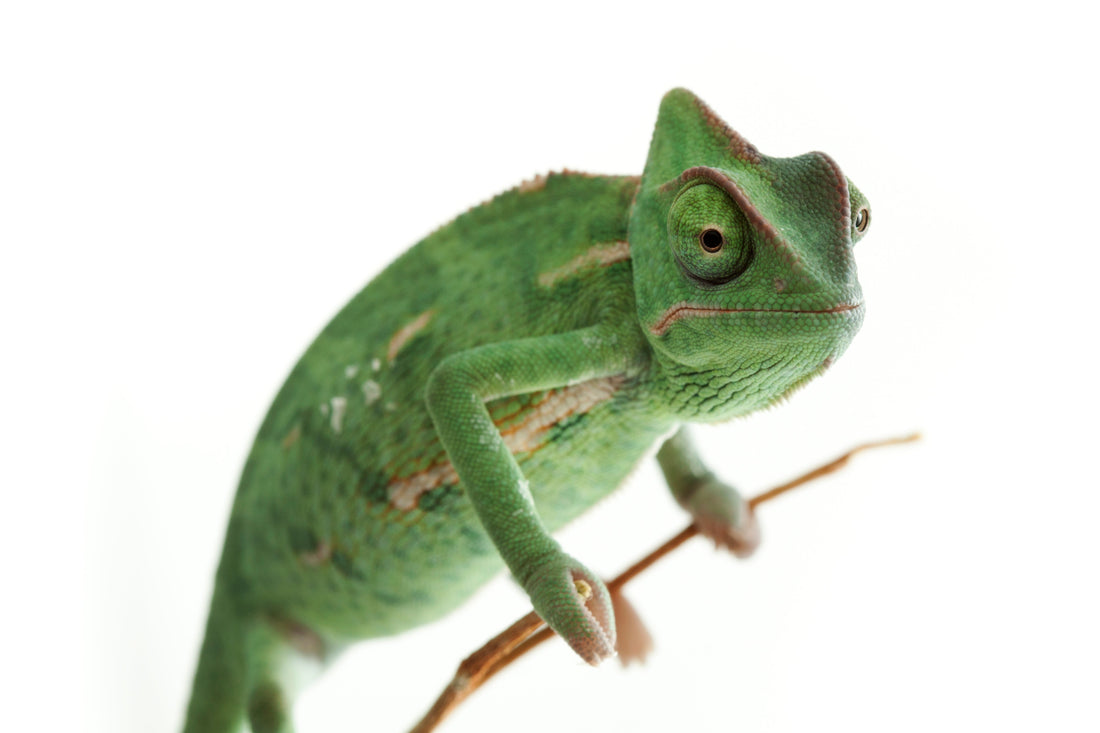Does your chameleon seem to insist on eating the same handful of food, ignoring everything else? If this is the case, you’re probably feeling frustrated and worried. Here’s a checklist of possible causes behind your pet’s lack of appetite.
Illness
Chameleons are very skilled at hiding when they’re not feeling well. This helps them avoid predators in the wild, but as pets, this talent tricks their owners as well. One of the first ways that lizards “tell” their owners that they’re not feeling well is through sudden, seemingly-unexplained appetite loss.
If your chameleon has suddenly become very picky about what they’ll eat, the first thing you want to do is check your pet’s husbandry. Are the basking or air temperatures too cool or hot? What tool do you use to measure that? Has your UVB bulb expired? (UVB bulbs need to be replaced every 6-12 months depending on the brand.) Is there something else that stands out to you when you review one of our chameleon care sheets?
If you still can’t find an explanation, take your chameleon to an experienced reptile veterinarian for examination. You can click here to search for one.
Feeding Too Often
How often do you feed your chameleon? Chameleons mature quickly, which means that they need to eat a lot in their 9 months or so of life. However, after they reach maturity, they start to eat a lot less — just a few bugs every other day.
If you’re still feeding your adult chameleon like it’s a baby, you’re feeding them too much and so they’re more likely to start picking and choosing what they want to eat. A hungry reptile isn’t a picky reptile, you see. It’s an evolutionary survival mechanism: In the wild, food is hard to find, so a chameleon that is picky about what to put in their stomach is more likely to starve to death. In other words, if they want to survive, they have to eat what’s available.
If overfeeding is your problem, the easiest solution is to correct your feeding schedule. This should help your chameleon feel more hungry when mealtime comes around. Occasionally skipping a feeding or two can also help keep your chameleon more motivated to eat.
Too Many Bugs
This is related to the above problem. Even if you are feeding your chameleon on an appropriate schedule for their age, if you offer too many bugs per feeding, it’s possible to cause the same problem. Generally speaking, 4-10 insects depending on the size and type should be a perfect portion size for an adult.
Too Many Treats
It’s always fun to give treats to our pets! However, if your chameleon is used to getting lots of high-fat treats on a regular basis, they can quickly lose their taste for normal, healthier foods — just like you’d probably rather have chocolate and bacon all the time, but they’re still not very good for you.
Keep the treats to a minimum in order to maintain your chameleon’s interest in foods that are lower in fat. One treat 1-2x/week is plenty. Exercising more self-control in this aspect will also help guard against obesity, organ dysfunction, and premature death. If you still crave that kind of interaction with your chameleon, try hand-feeding your pet rather than just dumping insects into their enclosure!
Limited Diet
Alternatively, maybe the problem is that your chameleon’s diet has stagnated. If you’ve been feeding your cham the same crickets and mealworms week after week, one of two things is likely to happen:
First, your chameleon may get so used to eating these foods that it doesn’t recognize anything else as food. Or, it may be so used to what’s familiar that it doesn’t find other foods palatable. The other possibility is that your chameleon is so used to getting the same old thing every day that it has lost interest in eating.
Either way, limited diet is a problem because variety is necessary to balanced nutrition. When your chameleon eats the same handful of foods every time, eventually it’s likely to develop a nutritional deficiency. Whatever the situation, the solution is more or less the same: remove familiar foods from your chameleon’s routine and offer other things until they get hungry enough to consider alternative possibilities. Open your mind to alternative feeders such as snails, silkworms, dubias, discoids, grasshopper, and black soldier flies!
Note, however, that each chameleon is an individual, and sometimes they simply don’t like the taste of a particular food. If your pet consistently rejects something, even when their favorite food has been removed from the rotation for a while, that means you should try something else.











